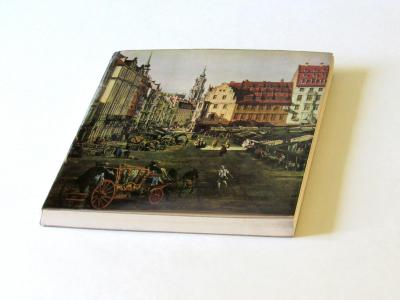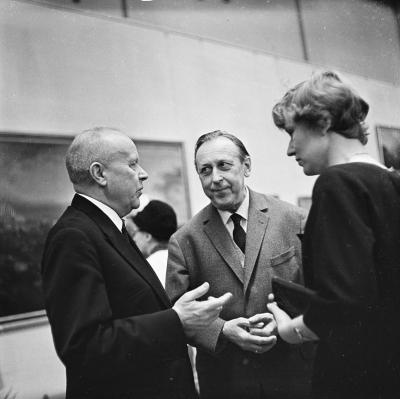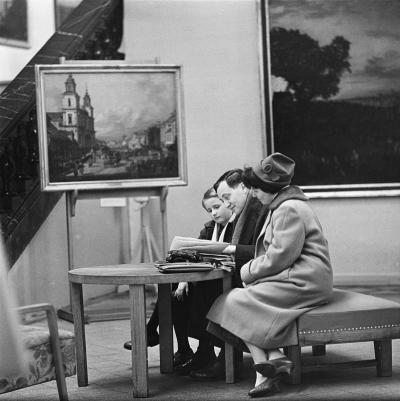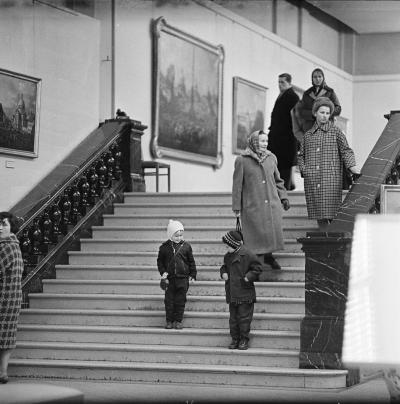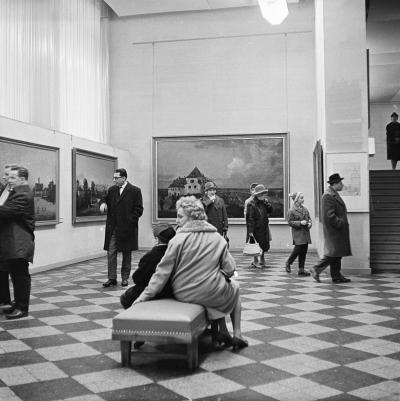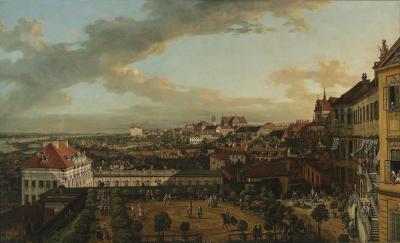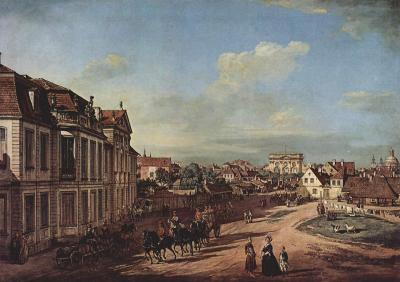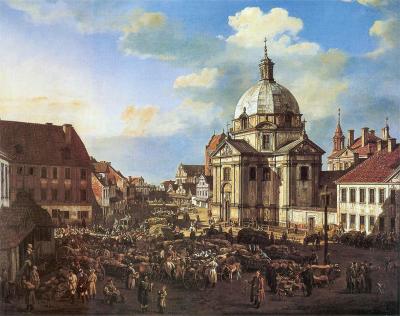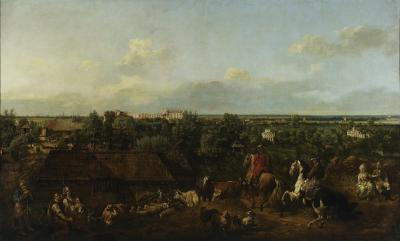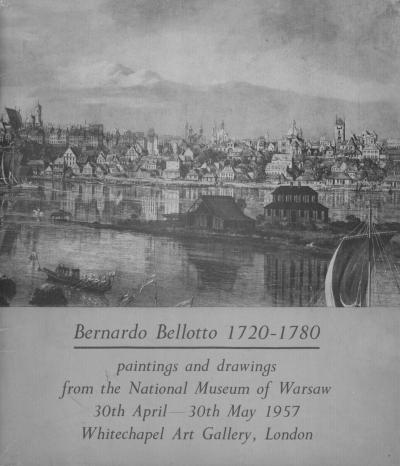The German-Polish Canaletto Exhibition in Dresden, Warsaw and Essen 1963-1966
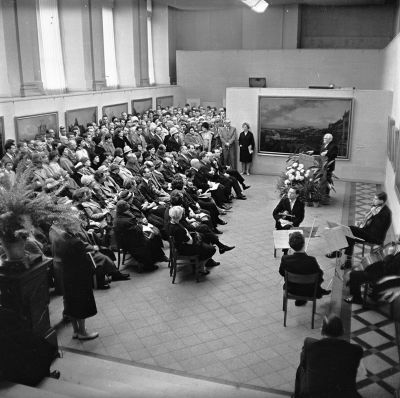
The Treaty of Zgorzelec (Görlitz) on 6th July 1950 fixed the border between the GDR and Poland along the Oder-Neiße Line. Now that the eastern areas of Germany were clearly lost forever-this fuelled suppressed – because forbidden – vindictive attitudes amongst much of the East German population. For this reason neither the political leadership nor the people of Poland felt able to trust the immutability of the border demarcation. Following the Poznan workers uprising in Poland in June 1956 Władysław Gomułka, the newly elected head of the Polish United Workers’ Party (PVAP), began a process of liberalisation in cultural and religious areas and did away with the forced collectivisation of agriculture. These measures caused the Chairman of the Central Committee of the SED, Walter Ulbricht to fear that demands for such reforms would also bleed into the GDR. The Oder-Neiße border was one of the most heavily guarded boundaries in Europe. The Poles considered that “any attempt to change it“ would be tantamount to a “call for war”.[1] Polish citizens who needed a visa to cross the border were reminded of the Nazi era by the harsh military tones of the East German border guards and the cut of their uniforms. The annual “friendship meetings“ in which German and Polish party functionaries met up to celebrate the anniversary of the Treaty of Zgorzelec and invoke the “peace border” failed to hide the fact that there were “very few contacts between the leadership in East Berlin and Warsaw”.[2]
Thus, according to Tadeusz Galiński, the Minister of Art and Culture in the People’s Republic of Poland, the Canaletto exhibition – jointly prepared by staff of the National Museum in Warsaw and the State Art Collections in Dresden – which opened on Sunday 8th December 1963 in the Dresden Albertinum “played an important role in the neighbourly cooperation between both countries, because it helped the people on both sides of the border to get to know each other better”, as he wrote in a preface to the exhibition catalogue. Hans Bentzien, the Minister of Culture in the German Democratic Republic referred to a “vibrant exchange of culture […] in the course of the last few years […] However never before has such a major exhibition been jointly prepared and presented by both countries.”
In 1747 the Venetian painter Bernardo Bellotto was only 25 when he was appointed Court Artist by King August III of Poland, who was also the Elector of Saxony Prince Friedrich August II. Consequently Bellotto painted a huge number of views of Dresden and Pirna for him. After the death of the Prince in 1763, the artist who now called himself Canaletto after his mother’s maiden name, moved to the court of Stanislaw II (Stanislav August Poniatowski), who was elected King of Poland in1764. Here Canaletto was commissioned to paint twenty-five views of Warsaw. But there were also common factors in more recent history: according to Hans Bentzien, the paintings in Warsaw were “highly endangered by the invasion of the Hitler fascists and were only saved from the flames of the burning palace by the personal efforts of museum staff, whereas in Dresden at the end of the war in May 1945 the artworks were rescued from extinction by special fighting units of the victorious Soviet army.” Galiński added: “Furthermore they have a major documentary value for Warsaw because they provided a blueprint for the reconstruction and repair of precious historical buildings in the old city districts. Thus works which bear witness to our national tradition which the Hitler fascists would have destroyed, have been saved for posterity.”
Immediately after the end of the war thirteen of a total of thirty-five Canaletto’s Dresden pictures were removed to Moscow along with the stocks of the Dresden Painting Gallery. In 1955 they were returned to the German Democratic Republic. Those paintings which remained in Dresden after the war were presented in Pillnitz Castle in 1946. The German/Polish Canaletto exhibition in 1963 was the first occasion when the complete Dresden stocks were united.[3] After the uprising against Russian rule in Warsaw was put down in 1831 the paintings in the Warsaw State Palace were removed to Russia and distributed amongst the palaces on the orders of the Czar. In 1922 they were returned to Poland by the Soviet government and could once again be seen in the Warsaw State Palace.[4] Thus a large part of the works shown in the Dresden exhibition in 1963 had served as spoils of war or for other political ends in the past.
The Polish side of the Dresden Canaletto exhibition was prepared by Stefan Kozakiewicz, the curator of the Warsaw National Museum. In 1972 he published the first comprehensive critical examination of the complete works of Bellotto. It was published in Recklinghausen in two volumes comprising more than 500 pages and 800 illustrations. In Dresden the exhibition was organised by the director of the Painting Gallery, Henner Menz, assisted by Waltraut Schumann. The exhibition comprised 31 paintings and 61 drawings from the National Museum in Warsaw and the Silesian Museum in Breslau/Wrocław, 35 paintings from the Gallery of Old Masters in the Dresden State Art Collection, as well as two vedutas from the collection of the State Palaces and gardens in Wörlitz. The 234-page catalogue with articles by all the participating specialists and 131 full-page black-and-white illustrations set and printed by the Otto Grotewohl Trade Vocational School in Leipzig, was selected as one of the finest books of the year in which it appeared.
[1] Polen. Oder-Neiße-Grenze. Das große Tabu, in: Der Spiegel, (22/11/1961), no. 48, p. 54.
[2] Sergiusz Michalski (2011), p. 686.
[3] Bernardo Bellotto, Ausstellungskatalog Dresden (1963), p. 49.
[4] Bernardo Bellotto, Ausstellungskatalog Dresden (1963), p. 61.
The exhibition was presented in the ground floor of the Albertinum that had served as a gallery since the end of the 19th century. The building was heavily damaged during the Second World War but reopened in 1956 with a huge number of collections including the restored Canaletto paintings from the Soviet Union. Three and a half million people visited the museum until 1963.[5] Thus only the Canaletto stocks from Warsaw and Breslau were really “new” to the people of Dresden. The general director of the Dresden State Art Collections, Max Seydewitz –he was the Minister-President of Saxony from 1947 to 92 – linked the exhibition with the hope of “deepening the friendship between the German and Polish people”, for “friendship between peoples is an important precondition for guaranteeing a permanent peace”. The general director of the National Museum in Warsaw, Stanisław Lorentz, a music specialist and art historian who had been decorated as a former resistance fighter for documenting Polish cultural possessions under the German occupation, desisted from any political appraisal. Instead his contribution to the catalogue noted the “importance of the pictures by Bernardo Bellotto in rebuilding Warsaw“. The rebuilding work was scrupulously orientated on the baroque vedutas of the silhouette of the city and its individual buildings, but not without questioning them critically.
In comparison to the following stops in Vienna and Essen the Dresden exhibition was visited by around 120,000 guests in nine months.[6] During the same period the whole of the State Art Collections counted around 1,900,000 guests.[7] Photographs of the exhibition by the freelance journalists Erich Höhne and Erich Pohl and which were also shown in the daily press,[8] show well-dressed, well educated visitors not only studying the paintings but also deeply engrossed in the catalogue. Daily papers like the Neue Zeit, the Neue Deutschland and the Berliner Zeitung, (which published pictures of Canaletto’s Warsaw view of the “Kraków suburb”), published lengthy reports.[9] On the 12th and 13th May 1964 the State Art Collections in Dresden organised a conference of the participating academics from Poland and Germany. From September to November of that year the exhibition was shown in the National Museum in Warsaw. On this occasion General Director Seydewitz gave a cocktail reception in the Bristol Hotel in Warsaw, that was attended by leading personalities of cultural life in Poland, the German and Italian ambassadors, and Canaletto research workers from the USSR, Italy, the USA, England and West Germany.[10] The exhibition then moved on to Kraków and Vienna, including more loans from the Leningrad Hermitage Museum, the Pushkin Museum in Moscow and the Art History Museum in Vienna.
The exhibition also aroused great interest in West Germany. “The idea came to German capitalists in the communist East“ wrote the magazine “Der Spiegel“ on 2nd May 1966. “After the general manager of the Krupp concern Berthold Beitz saw the pictures of an ancient Italian in the National Museum in Warsaw he also wanted to view them in Germany.”[11] Beitz, who had been an intimate friend of Alfried Krupp von Bohlen und Halbach since 1953, had built up close connections with Poland for many years. As early as February 1958 he travelled to the first business conferences held in Warsaw;[12] and in December 1960 he was invited to a state visit by the Polish Prime Minister Józef Cyrankiewicz. Here, with the unspoken consent of the German chancellor Konrad Adenauer, he negotiated closer economic relationships between West Germany and Poland.[13] He also met up with the Minister for Foregin Trade, Trąmpczyński and the head of the Communist Party, Gomułka. In any case Beitz enjoyed a high reputation in Poland. In September 1939 he was commanded by the head of the German Armed Forces to administrate the oilfields in Galicia. Here, between 1941 and 1944, he and his wife hid Jews and Poles from the Gestapo in the city of Borysłav, amongst others. Cyrankiewicz suggested that the two countries should intensify cultural relationships as a first step towards more general closer relationships, and offered to lend some Egyptian works for an exhibition in the Villa Hügel in Essen in May 1961.[14]
[5] Bernardo Bellotto, Ausstellungskatalog Dresden (1963), p.15.
[6] In Vienna, the exhibition counted 42,000 visitors from April 29 to August 25 1965 (Berliner Zeitung from 08/25/1965), in Essen 51,000 visitors from April 29 to July 31 1966, villahuegel.de.
[7] Neues Deutschland (18/9/1964).
[8] Berliner Zeitung and Neues Deutschland (14/12/1963).
[9] Neue Zeit (12/1/1964); Neues Deutschland (15/1/1964); Berliner Zeitung (22/1/1964).
[10] Neues Deutschland (4/10/1964).
[11] Der Spiegel (1966), no. 19, p. 166.
[12] Der Spiegel (1961), no. 6, p. 16.
[13] Der Spiegel (1961), no. 6, p. 17.
[14] Der Spiegel (1961), no. 6, p. 18; Exhibition „5000 Jahre Ägyptische Kunst“, Villa Hügel, Essen (15/05/1961 – 27/08/1961), villahuegel.de.
Beitz was able to reap the reward for his efforts in 1963. In March Germany and Poland made a trade agreement intended to “begin a new era in German policies towards Eastern European countries“.[15] During this time Beitz, Cyrankiewicz and Gomułka who, as in previous years, had met up in the German Pavilion at the trade fair in Posen/Poznań, had become close friends.[16] When Beitz visited the Canaletto exhibition in Warsaw in 1964 he used his contacts with the Minister for Foreign Trade, Trąmpczyński, to meet up with a Krupp associate in East Berlin and the Soviet ambassador Andrei Smirnow, not only to arrange for the Dresden-Warsaw exhibition to be taken to the Villa Hügel in Essen but also to include loans from the Hermitage and the Pushkin Museum. The exhibition opened in Essen on 28th April 1966. Krupp agreed to provide the insurance sum of around 12 million marks. In March the business head of the Villa Hügel, Carl Hundhausen, sent an invitation to the GDR Minister of Culture Klaus Gysi to be present at the opening in Essen in recognition of the loans from the Dresden Painting Gallery.[17] But the foreign office intervened and the Federal Chancellor Ludwig Erhard decided to refuse to allow Gysi to enter the country. As a result Hundhausen was forced to withdraw his invitation by telegram.[18] The reasons for these measures were never made public. The GDR press reported the events in critical articles and commentaries[19] and the State Art Collections in Dresden published an open letter protesting against the refusal to grant Gysi permission to travel.[20] In the West German weekly “Die Zeit” Gottfried Sello condemned the decision as: “a shameful and incomprehensible measure: if pictures are allowed to pass through the border without hindrance […]the men responsible for the pictures and the loans should also be allowed to travel”.[21] A positive commentary in the “Frankfurter Rundschau” remarked that this was the first time that an “exhibition in the Federal Republic had been created with fundamental help from countries to the east”. The “Stuttgarter Zeitung” wrote: “The exhibition in the Villa Hügel is, so to speak, the intellectual table decoration for trade and the symbol of a change of policy by the Krupp firm towards Eastern Europe.”[22]
Axel Feuß, August 2015
Further reading:
Ludwig Mehlhorn: Die Sprachlosigkeit zwischen Poland and der GDR. Eine Hypothek, in: Deutsche and Poland. 100 Schlüsselbegriffe, edited by Ewa Kobylińska, Munich 1993, pp. 522-528.
Wolf-Dieter Eberwein / Basil Kerski (eds.): Die deutsch-polnischen Beziehungen 1949-2000. Eine Werte- and Interessengemeinschaft, Opladen 2001.
Basil Kerski / Andrzej Kotula / Kazimierz Wóycicki (eds.): Zwangsverordnete Freundschaft? Die Beziehungen zwischen der GDR and Poland 1949-1990, Osnabrück 2003.
Sergiusz Michalski: Eine kalte Freundschaft. Die Beziehungen zwischen der Volksrepublik Poland and der Deutschen Demokratischen Republik, in: Tür an Tür. Poland - Deutschland. 1000 Jahre Kunst and Geschichte, edited by Małgorzata Omilanowska, Cologne 2011, pp. 686-691.
Bernardo Bellotto named Canaletto in Dresden and Warschau, Exhibition from 8 Dezember 1963 until 31. August 1964, edited by the Generaldirektion der Staatlichen Kunstsammlungen Dresden, Albertinum, Dresden 1963.
Summary of the Scientific Conference Bernardo Bellotto named Canaletto, organized at 12. and 13. Mai 1964 by the Staatlichen Kunstsammlungen Dresden, in Gemälde Galerie Alte Meister on the occasion of the German-Polish Bellotto-Exhibition, Dresden 1964 (15 pages).
Drezno i Warszawa w twórczości Bernarda Bellotta Canaletta. Wystawa zorganizowana wspólnie przez państwowe zbiory sztuki w Dreźnie, Galerie̜ Dawnych Mistrzów i Muzeum Narodowe w Warszawie. Catalogue, Warsaw 1964
Bernardo Bellotto Caneletto. Wystawa zorganizowana wspólnie przez Państwowe Zbiory Sztuki w Dréznie, Galerie Dawnych Mistrzów i Muzeum Narodowe w Warszawie przy współudziale Kunsthistorisches Museum w Wiedniu, Pánstwowego Ermitazu w Leningradzie i Muzeum Sztuk Plastycznych im. A.S. Puszkina w Moskwie. Przewodnik. [Wystawa] 1964-1965, Muzeum Narodowe w Krakowie, Kraków 1964
Bernardo Bellotto named Canaletto. Exhibition under the direction of: Staatliche Kunstsammlung Dresden, Nationalmuseum Warschau, Kunsthistorisches Museum Vienna organized by the Austrian Cultural Association, Vienna , Oberes Belvedere, April 29 to July 25 in 1965, Vienna in 1965.
European vedute of Bernardo Bellotto named Canaletto. Exhibition from April 29 to July 31 in 1966 in the Villa Hügel in Essen, edited by the Villa Hügel e.V.,
[15] Der Spiegel (1963), no. 26, p. 25.
[16] Der Spiegel (1963), no. 26, p. 26.
[17] Letter of invitation (22/3/1966), illustrated in Neues Deutschland (21/5/1966).
[18] Illustration in Neues Deutschland (21/5/1966).
[19] Berliner Zeitung (21/5/1966 and 22/5/1966); Neues Deutschland (21/5/1966).
[20] Neues Deutschland (26/5/1966).
[21] Die Zeit (1966), no. 27.
[22] Press Release: 50 Jahre Kunst in der Villa Hügel. Chronologie eines außergewöhnlichen Mäzenatentums (April 2003), villahuegel.de.
